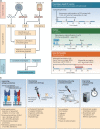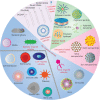Nanomaterial-based delivery vehicles for therapeutic cancer vaccine development
- PMID: 33979069
- PMCID: PMC8185868
- DOI: 10.20892/j.issn.2095-3941.2021.0004
Nanomaterial-based delivery vehicles for therapeutic cancer vaccine development
Abstract
Nanomaterial-based delivery vehicles such as lipid-based, polymer-based, inorganics-based, and bio-inspired vehicles often carry distinct and attractive advantages in the development of therapeutic cancer vaccines. Based on various delivery vehicles, specifically designed nanomaterials-based vaccines are highly advantageous in boosting therapeutic and prophylactic antitumor immunities. Specifically, therapeutic vaccines featuring unique properties have made major contributions to the enhancement of antigen immunogenicity, encapsulation efficiency, biocompatibility, and stability, as well as promoting antigen cross-presentation and specific CD8+ T cell responses. However, for clinical applications, tumor-associated antigen-derived vaccines could be an obstacle, involving immune tolerance and deficiency of tumor specificities, in achieving maximum therapeutic indices. However, when using bioinformatics predictions with emerging innovations of in silico tools, neoantigen-based therapeutic vaccines might become potent personalized vaccines for tumor treatments. In this review, we summarize the development of preclinical therapeutic cancer vaccines and the advancements of nanomaterial-based delivery vehicles for cancer immunotherapies, which provide the basis for a personalized vaccine delivery platform. Moreover, we review the existing challenges and future perspectives of nanomaterial-based personalized vaccines for novel tumor immunotherapies.
Keywords: Nanomaterial-based delivery vehicles; bioinformatic prediction; neoantigen; personalized vaccines; tumor immunotherapy.
Copyright © 2021 Cancer Biology & Medicine.
Conflict of interest statement
No potential conflicts of interest are disclosed.
Figures



Similar articles
-
Prescription of Controlled Substances: Benefits and Risks.2025 Jul 6. In: StatPearls [Internet]. Treasure Island (FL): StatPearls Publishing; 2025 Jan–. 2025 Jul 6. In: StatPearls [Internet]. Treasure Island (FL): StatPearls Publishing; 2025 Jan–. PMID: 30726003 Free Books & Documents.
-
Optimized polyepitope neoantigen DNA vaccines elicit neoantigen-specific immune responses in preclinical models and in clinical translation.Genome Med. 2021 Apr 21;13(1):56. doi: 10.1186/s13073-021-00872-4. Genome Med. 2021. PMID: 33879241 Free PMC article.
-
Immunomodulatory nanoparticles activate cytotoxic T cells for enhancement of the effect of cancer immunotherapy.Nanoscale. 2024 Oct 3;16(38):17699-17722. doi: 10.1039/d4nr01780c. Nanoscale. 2024. PMID: 39257225 Review.
-
Immunogenicity and seroefficacy of pneumococcal conjugate vaccines: a systematic review and network meta-analysis.Health Technol Assess. 2024 Jul;28(34):1-109. doi: 10.3310/YWHA3079. Health Technol Assess. 2024. PMID: 39046101 Free PMC article.
-
Oncolytic reovirus enhances the effect of CEA immunotherapy when combined with PD1-PDL1 inhibitor in a colorectal cancer model.Immunotherapy. 2025 Apr;17(6):425-435. doi: 10.1080/1750743X.2025.2501926. Epub 2025 May 12. Immunotherapy. 2025. PMID: 40353308
Cited by
-
Cancer vaccines in the clinic.Bioeng Transl Med. 2023 Oct 27;9(1):e10588. doi: 10.1002/btm2.10588. eCollection 2024 Jan. Bioeng Transl Med. 2023. PMID: 38193112 Free PMC article. Review.
-
Co-Delivery of the Human NY-ESO-1 Tumor-Associated Antigen and Alpha-GalactosylCeramide by Filamentous Bacteriophages Strongly Enhances the Expansion of Tumor-Specific CD8+ T Cells.Viruses. 2023 Mar 2;15(3):672. doi: 10.3390/v15030672. Viruses. 2023. PMID: 36992381 Free PMC article.
-
Bacterial outer membrane vesicle-based cancer nanovaccines.Cancer Biol Med. 2022 Sep 23;19(9):1290-300. doi: 10.20892/j.issn.2095-3941.2022.0452. Cancer Biol Med. 2022. PMID: 36172794 Free PMC article. Review.
-
Lipid-Based Delivery Systems in Development of Genetic and Subunit Vaccines.Mol Biotechnol. 2023 May;65(5):669-698. doi: 10.1007/s12033-022-00624-8. Epub 2022 Dec 3. Mol Biotechnol. 2023. PMID: 36462102 Free PMC article. Review.
-
mRNA Delivery Platform Based on Bacterial Outer Membrane Vesicles for Tumor Vaccine.Bio Protoc. 2023 Jul 5;13(13):e4774. doi: 10.21769/BioProtoc.4774. eCollection 2023 Jul 5. Bio Protoc. 2023. PMID: 37456344 Free PMC article.
References
-
- Starnes CO. Coley’s toxins in perspective. Nature. 1992;357:11–2. - PubMed
-
- Morales A, Eidinger D, Bruce AW. Intracavitary Bacillus Calmette-Guerin in the treatment of superficial bladder tumors. J Urol. 1976;116:180–3. - PubMed
-
- Van der Bruggen P, Traversari C, Chomez P, Lurquin C, De Plaen E, Van den Eynde B, et al. A gene encoding an antigen recognized by cytolytic T lymphocytes on a human melanoma. Science. 1991;254:1643–7. - PubMed
Publication types
Grants and funding
- 2018YFA0208900/National Key R&D Program of China
- 2018YFE0205300/National Key R&D Program of China
- Z200020/Beijing Natural Science Foundation of China
- Z201100006820031/Beijing Nova Program
- ts20190987/Taishan Scholars Program of Shandong Province
- 31800838/National Natural Science Foundation of China
- 31820103004/National Natural Science Foundation of China
- 31730032/National Natural Science Foundation of China
- 31800799/National Natural Science Foundation of China
- QYZDJ-SSW-SLH022/Key Research Project of Frontier Science of the Chinese Academy of Sciences
- 11621505/Innovation Research Group of National Natural Science Foundation
LinkOut - more resources
Full Text Sources
Research Materials
